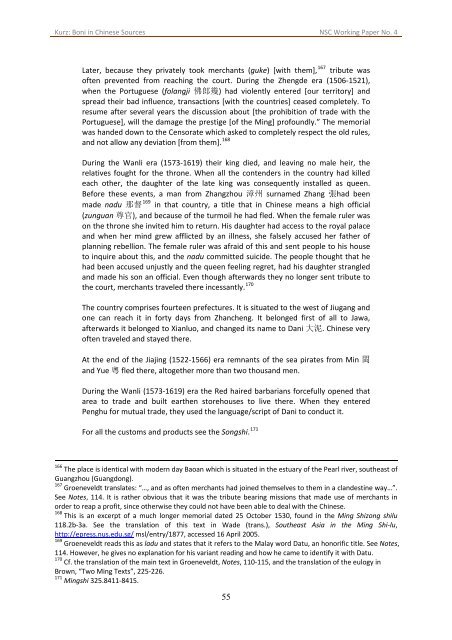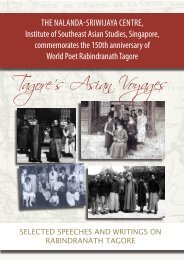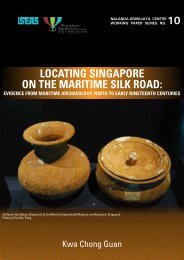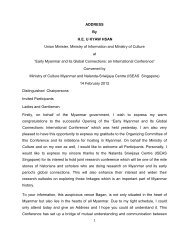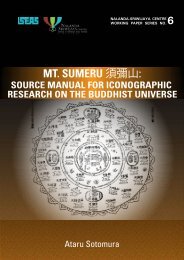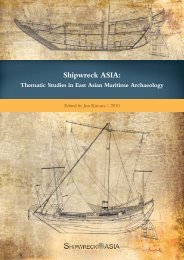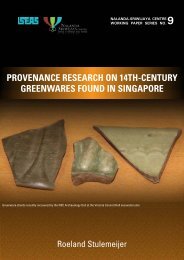Boni in Chinese Sources - Nalanda-Sriwijaya Centre - iseas
Boni in Chinese Sources - Nalanda-Sriwijaya Centre - iseas
Boni in Chinese Sources - Nalanda-Sriwijaya Centre - iseas
You also want an ePaper? Increase the reach of your titles
YUMPU automatically turns print PDFs into web optimized ePapers that Google loves.
Kurz: <strong>Boni</strong> <strong>in</strong> Ch<strong>in</strong>ese <strong>Sources</strong> NSC Work<strong>in</strong>g Paper No. 4Later, because they privately took merchants (guke) [with them], 167 tribute wasoften prevented from reach<strong>in</strong>g the court. Dur<strong>in</strong>g the Zhengde era (1506‐1521),when the Portuguese (folangji 佛 郎 幾 ) had violently entered [our territory] andspread their bad <strong>in</strong>fluence, transactions [with the countries] ceased completely. Toresume after several years the discussion about [the prohibition of trade with thePortuguese], will the damage the prestige [of the M<strong>in</strong>g] profoundly.” The memorialwas handed down to the Censorate which asked to completely respect the old rules,and not allow any deviation [from them]. 168Dur<strong>in</strong>g the Wanli era (1573‐1619) their k<strong>in</strong>g died, and leav<strong>in</strong>g no male heir, therelatives fought for the throne. When all the contenders <strong>in</strong> the country had killedeach other, the daughter of the late k<strong>in</strong>g was consequently <strong>in</strong>stalled as queen.Before these events, a man from Zhangzhou 漳 州 surnamed Zhang 張 had beenmade nadu 那 督 169 <strong>in</strong> that country, a title that <strong>in</strong> Ch<strong>in</strong>ese means a high official(zunguan 尊 官 ), and because of the turmoil he had fled. When the female ruler wason the throne she <strong>in</strong>vited him to return. His daughter had access to the royal palaceand when her m<strong>in</strong>d grew afflicted by an illness, she falsely accused her father ofplann<strong>in</strong>g rebellion. The female ruler was afraid of this and sent people to his houseto <strong>in</strong>quire about this, and the nadu committed suicide. The people thought that hehad been accused unjustly and the queen feel<strong>in</strong>g regret, had his daughter strangledand made his son an official. Even though afterwards they no longer sent tribute tothe court, merchants traveled there <strong>in</strong>cessantly. 170The country comprises fourteen prefectures. It is situated to the west of Jiugang andone can reach it <strong>in</strong> forty days from Zhancheng. It belonged first of all to Jawa,afterwards it belonged to Xianluo, and changed its name to Dani 大 泥 . Ch<strong>in</strong>ese veryoften traveled and stayed there.At the end of the Jiaj<strong>in</strong>g (1522‐1566) era remnants of the sea pirates from M<strong>in</strong> 閩and Yue 粵 fled there, altogether more than two thousand men.Dur<strong>in</strong>g the Wanli (1573‐1619) era the Red haired barbarians forcefully opened thatarea to trade and built earthen storehouses to live there. When they enteredPenghu for mutual trade, they used the language/script of Dani to conduct it.For all the customs and products see the Songshi. 171166 The place is identical with modern day Baoan which is situated <strong>in</strong> the estuary of the Pearl river, southeast ofGuangzhou (Guangdong).167 Groeneveldt translates: “…, and as often merchants had jo<strong>in</strong>ed themselves to them <strong>in</strong> a clandest<strong>in</strong>e way…”.See Notes, 114. It is rather obvious that it was the tribute bear<strong>in</strong>g missions that made use of merchants <strong>in</strong>order to reap a profit, s<strong>in</strong>ce otherwise they could not have been able to deal with the Ch<strong>in</strong>ese.168 This is an excerpt of a much longer memorial dated 25 October 1530, found <strong>in</strong> the M<strong>in</strong>g Shizong shilu118.2b‐3a. See the translation of this text <strong>in</strong> Wade (trans.), Southeast Asia <strong>in</strong> the M<strong>in</strong>g Shi‐lu,http://epress.nus.edu.sg/ msl/entry/1877, accessed 16 April 2005.169 Groeneveldt reads this as ladu and states that it refers to the Malay word Datu, an honorific title. See Notes,114. However, he gives no explanation for his variant read<strong>in</strong>g and how he came to identify it with Datu.170 Cf. the translation of the ma<strong>in</strong> text <strong>in</strong> Groeneveldt, Notes, 110‐115, and the translation of the eulogy <strong>in</strong>Brown, “Two M<strong>in</strong>g Texts”, 225‐226.171 M<strong>in</strong>gshi 325.8411‐8415.55


